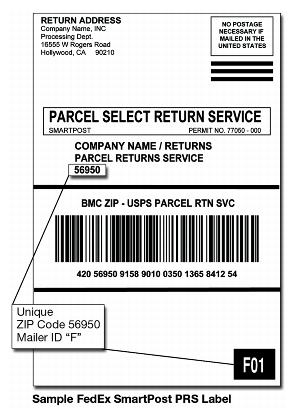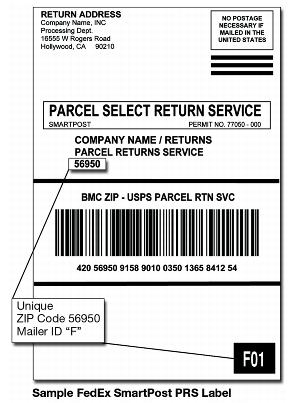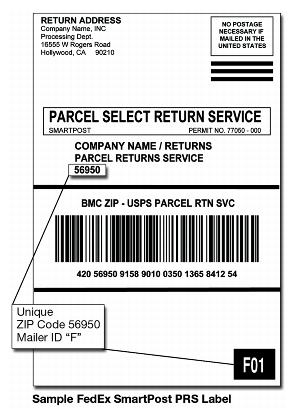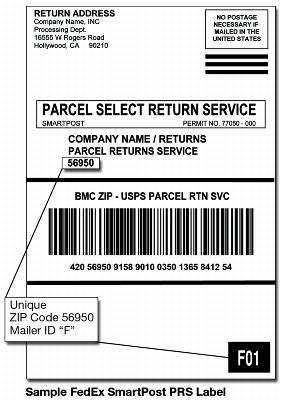This field information kit is designed to serve as information and reference about our new Parcel Return Service (PRS) customer, FedEx SmartPost, and contains the following items:
n Launch announcement.
n Employee Stand-up Talks:
n Back Office.
n Retail Associates.
n All Carriers.
n Network Distribution Centers (NDCs).
n PRS Return Delivery Unit (RDU) Work Instructions Overview.
n Frequently Asked Questions (FAQs).
Parcel Return Service — Continued Growth!
Beginning September 10, 2009, USPS® gained FedEx SmartPost as a new PRS customer. FedEx SmartPost will be providing PRS labels for consumers to return packages — originally shipped to them by FedEx SmartPost — to merchants. PRS labels will provide consumers the convenience of using USPS collection boxes, Post Office™ facilities, and Carrier Pickup™ service from home or business addresses for the return of their packages. It is critical that personnel in all retail offices, all carriers, plant personnel, and NDC personnel be able to identify, accept, and process these packages according to their respective service requirements.
Return packages continue to be a growing market segment, thanks to increased Internet and catalog sales and the recycling of small electronics. Market studies indicate that in order to maintain consumer loyalty and repeat business, the returns process must be easy. Parcel Return Service was developed for merchants that experience a large number of returns and want to provide their customers with a convenient return solution, using a combination of the Postal Service’s™ “first-mile” capabilities and shipping consolidators or reverse logistics providers, such as Newgistics, UPS, and now FedEx SmartPost, who are the merchants’ agents for package return. PRS has shown steady volume and revenue growth since its launch in 2003. PRS offers two pricing options, depending on the agent’s pickup point — RDUs or RNDCs.
Standup Talk for Back Office Employees: New PRS Customer — FedEx SmartPost
Beginning September 10, 2009, USPS gained FedEx SmartPost as a new Parcel Return Service (PRS) customer. FedEx SmartPost will be providing PRS labels for consumers to return packages — originally shipped to them by FedEx SmartPost — to merchants. This launch by FedEx SmartPost follows its testing of PRS with select merchants during the summer. Customers can give PRS packages to their mail carrier, leave them in their mailbox, drop them in a collection box, drop them off at the retail counter, or request Carrier Pickup service. USPS will process the PRS packages at designated Return Delivery Units (RDUs), where they will be picked up by FedEx SmartPost. PRS parcels dropped in collection boxes or facilities where FedEx SmartPost does not pick up will be sent to the Network Distribution Center (NDC) to be picked up. PRS items for the NDC must be placed in the RDC-01 container for dispatch.
Clerks should identify all parcels with a PRS label, accept them, and place them in the designated PRS staging area. FedEx SmartPost has a unique ZIP™ Code of 56950 and an alpha code of F.

Important: We have three PRS customers (the merchant’s agent) — you may be a designated RDU for none, one, two, or all three customers. You must handle each accordingly.
n Newgistics — 56901, alpha is “V”.
n UPS — 56902, alpha is “B”.
n FedEx SmartPost — 56950, alpha is “F”.
RDU Instructions: An office that has been designated as an RDU for any agent was sent a notification letter. The subject of this letter is Authorized Agent Notification for Parcel Return Services — Return Delivery Unit. This letter will also have a PS Form 3801, Standing Delivery Order, attached. This letter designates your unit as an RDU and signifies that the agent will pick up PRS parcels from your facility. It also states the agent’s name and unique ZIP Code. RDU offices have a responsibility to correctly scan these parcels and hold them for pickup in their facility. When processing and separating PRS items, you must look for the designated unique ZIP Code and Mailer ID that were mentioned in the notification letter.
Non-RDU Instructions: If you are not a designated RDU for a specific agent, send the parcels to the sectional center facility (SCF) or NDC without scanning them.
Again — you can be an RDU for none, one, two, or all three agents. You must know which parcels to hold and scan and which to send to the plant without scanning. If you do not know, ask your supervisor right now.
There are different PRS customers: Newgistics — 56901, UPS — 56902, and FedEx SmartPost 56950.
RDU Scanning Instructions
There are two correct scans (the scanner must be in the Returns Mode):
1. Available for Pickup — triggers pickup and payment. Perform this scan the day the parcel is received. If there is no scan, we do not get paid.
2. Picked up by Agent — change of custody. Perform this scan when the agent picks up the parcels.
Pickups are as follows:
n Newgistics picks up Mondays, Wednesdays, and Fridays.
n FedEx SmartPost and UPS will pick up when they drop off PRS drop shipments. Just give the scanned parcels to their drivers.
n Give the correct parcels to the correct agent. Verify the unique ZIP Code before handing off to the agent.
All Offices:
n Accept all PRS parcels (569XX).
n Separate PRS parcels by their unique ZIP Code.
n Handle each accordingly. If your office is an RDU for the agent, hold and scan; if your office is not an RDU for the agent, send to the plant without scanning.
n If your office is not an RDU for any or all of these agents and you are dispatching this mail, make sure you sort it to the RDC-01 separation if your office is using the Retail Distribution Codes (RDCs). If you are not yet using the RDCs, ask your supervisor.
PRS is a growing and profitable product. Its success depends on you! Please ask your supervisor if you have any questions.
Standup Talk for Retail Associates: New PRS Customer — FedEx SmartPost
Beginning September 10, 2009, USPS gained FedEx SmartPost as a new Parcel Return Service (PRS) customer. FedEx SmartPost will be providing PRS labels for consumers to return packages — originally shipped to them by FedEx SmartPost — to merchants. This launch by FedEx SmartPost follows its testing of PRS with select merchants during the summer. Customers can give PRS packages to their mail carrier, leave them in their mailbox, drop them in a collection box, drop them off at the retail counter, or request Carrier Pickup service. USPS will process the PRS packages at designated Return Delivery Units (RDUs), where they will be picked up by FedEx SmartPost. PRS parcels dropped in collection boxes or facilities where FedEx SmartPost does not pick up will be sent to the Network Distribution Center (NDC) to be picked up. PRS items for the NDC must be placed in the RDC-01 container for dispatch.
Clerks should identify all parcels with a PRS label, accept them, and place them in the designated PRS staging area. FedEx SmartPost has a unique ZIP Code of 56950 and an alpha code of F.
Points to Remember for Retail Window
n Retail associates are required to ask the HazMat question for all parcels accepted at the retail window.
n Retail associates accepting PRS packages do not enter the PRS ZIP Code into the POS or IRT system. Simply thank the customer, and deposit the packages into the appropriate designated container for back office/dispatch, separation, and scanning.
n Make sure PRS packages are not marked or prepared for expedited handling (Priority Mail® service or Express Mail® service).
n Extra Services are not permitted with the exception of Certificate of Mailing. You may offer this optional service.
n Handwritten or individually prepared labels are not permitted for PRS service.
n Do not line out PRS ZIP Code or barcodes or the FedEx SmartPost or other agent’s information.
n ZIP Code range 56900 thru 56999 is valid for PRS packages.
n If a PRS piece goes to an agent for which your office is not an RDU, and your office has begun using Retail Distribution Code (RDC) separations, place the PRS piece in the RDC-01 container. For purposes of processing and dispatch, PRS pieces that are not picked up at the RDU are treated as local service area mail and will be picked up at your host NDC.

Remember: No acceptance scan or retail transaction is required. Special Service add-ons are not allowed, other than Certificate of Mailing.
If we do it right, we can build volume, and that will give us more PRS packages to accept, collect, and process. PRS has generated significant new revenue since it launched in October 2003, and merchants and their agents count on us to process returns correctly. We need your help to keep PRS successful. Keeping these simple processes in mind will help us serve customers better as more of them learn about — and use — this great service.
Please ask your supervisor if you have any questions.
Standup Talk for All Carriers: New PRS Customer — FedEx SmartPost
Beginning September 10, 2009, USPS gained FedEx SmartPost as a new Parcel Return Service (PRS) customer. FedEx SmartPost will be providing PRS labels for consumers to return packages — originally shipped to them by FedEx SmartPost — to merchants. This launch by FedEx SmartPost follows its testing of PRS with select merchants during the summer. Customers can give PRS packages to their mail carrier, leave them in their mailbox, drop them in a collection box, drop them off at the retail counter, or request Carrier Pickup service. USPS will process the PRS packages at designated Return Delivery Units (RDUs), where they will be picked up by FedEx SmartPost. PRS parcels dropped in collection boxes or facilities where FedEx SmartPost does not pick up will be sent to the Network Distribution Center (NDC) to be picked up. PRS items for the NDC must be placed in the RDC-01 container for dispatch.
Carriers should identify all parcels with a PRS label, bring them back, and place them in the designated PRS staging area. FedEx SmartPost has a unique ZIP Code of 56950 and an alpha code of F.

To identify FedEx SmartPost PRS items, locate the following:
n The designated unique ZIP Code “56950”.
n The Mailer ID of “F” (the 2- to 4-digit number following the alpha letter is not relevant).
Remember:
n We have multiple PRS customers:
n Newgistics — 56901.
n UPS — 56902.
n FedEx SmartPost — 56950.
n Bring all PRS parcels back, and place them in the area designated by your supervisor.
n Carriers do not scan PRS parcels.
The success of this service depends on you to identify and properly handle PRS packages.
If we do it right, we can build volume, and that will give us more PRS packages to accept, collect, and process. PRS has generated significant new revenue since it launched in October 2003, and merchants and their agents count on us to process returns correctly. We need your help to keep PRS successful. Keeping these simple processes in mind will help us serve customers better as more of them learn about — and use — this great service.
Please ask your supervisor if you have any questions.
Standup Talk for NDCs: New PRS Customer — FedEx SmartPost
Beginning September 10, 2009, USPS gained FedEx SmartPost as a new Parcel Return Service (PRS) customer. FedEx SmartPost will be providing PRS labels for consumers to return packages — originally shipped to them by FedEx SmartPost — to mechants. This launch by FedEx SmartPost follows its testing of PRS with select merchants during the summer. Customers can give PRS packages to their mail carrier, leave them in their mailbox, drop them in a collection box, drop them off at the retail counter, or request Carrier Pickup service. USPS will process the PRS packages at designated Return Delivery Units (RDUs), where they will be picked up by FedEx SmartPost. PRS parcels dropped in collection boxes or facilities where FedEx SmartPost does not pick up will be sent to the Network Distribution Center (NDC) to be picked up. PRS items for the NDC must be placed in the RDC-01 container for dispatch.
When FedEx SmartPost PRS parcels arrive at the NDC, sort them like other parcels.
If parcels share a run out, 100 percent verification of the ZIP Code is required.
We have multiple PRS customers, and the labels on these parcels are similar. It is essential that you look specifically for the unique ZIP Code on the label.
If the barcode does not scan and keying is required, you must key the entire 5 digits of the ZIP Code. Provide the attached sample for employee review and post in keying areas.
Once sorted, the parcels must be containerized, placarded, and staged for pickup by FedEx SmartPost. Make sure that you are sorting correctly by unique ZIP Code, and keep parcels for all agents separate.
In summary, these are the key points you need to remember:
n FedEx is a new PRS customer; its unique ZIP Code is 56950.
n We have multiple PRS customers
n Newgistics — 56901, alpha code is “V”
n UPS — 56902, alpha code is “B”
n FedEx SmartPost — 56950, alpha code is “F”
n Once PRS parcels are sorted by unique 569XX ZIP Codes, they must be placarded and staged separately. They must not be commingled.
n It is critical to give the correct parcels to the correct customers.
If you have any questions or are not sure what to look for, contact your supervisor.
We are counting on you to continue to make PRS a success!

PRS Return Delivery Unit Work Instructions Overview
Identify PRS parcels, unique ZIP Codes 56901–56999, from the following locations:
n Retail operations.
n Carrier routes.
n Collection boxes.
Retail
n Ask the HazMat question if items are presented at the retail counter.
n Ensure that no POS/IRT transaction is performed (no weighing, rating, zero PVI, or scanning. Only one Special Service is allowed — Certificate of Mailing). A nonrevenue transaction should be entered.
n Deposit PRS parcels in a designated container (scanning will be done by back office/dispatch personnel).
n PRS pieces being dispatched (not being picked up by agent) must be sorted to an RDC-01 container
Carrier
n Separate all PRS parcels from other collection mail.
n Upon return to unit, deposit all PRS parcels in the designated PRS container.
n Letter carriers should not scan any PRS parcels collected.
Collections
n Upon return to the unit, deposit PRS packages in the designated PRS container.
n Collectors should not scan any PRS parcels collected.
Note: For those collection routes not returning to the unit, it is not necessary to separate PRS parcels, as these parcels will be dispatched to the NDC.
Back Office Employee
n Retrieve PRS parcels from designated containers.
n Ensure PRS packages are for ZIP Codes 56901–56999.
n Sort all PRS by the unique 569 ZIP Code and alpha mailer ID.
n Perform the following on PRS parcels if you are a designated RDU for that agent:
n In Main Options on the handheld scanner:
n Select “Returns Mode” (Option A).
n Scan barcode.
n Select “Available for Pickup” (Option 1) & Date packages.
n Place scanned parcels in designated separation by unique ZIP Code for agent pickup.
n Placard and dispatch any other ZIP Code packages that are not picked up at your facility to the RSCF or NDC, as directed by your supervisor.
n PRS pieces being dispatched (not being picked up by agent) must be sorted to an RDC-01 container.
Returning Parcels to the Merchant/Agent
n Ensure a PS Form 3801 is on file and contains the signature of the agent.
n In Main Options on the handheld scanner:
n Select “Returns Mode” (Option A).
n Scan barcode.
n Select “Picked Up By Agent” (Option 2).
n Complete and retain PS Form 6354, Parcel Return Service Dispatch Log.
n Parcels may be returned to the merchant/agent after scanning and logging is complete.
n Ensure correct PRS parcels are given to the correct agents. Labels are similar: verify unique ZIP Code on all parcels when tendering to agent.
Oversized Parcels
n Identify and set aside any oversized parcels (over 108", but not more than 130" in combined length & girth) for additional scanning steps.
n In Main Options on the handheld scanner:
n Select “Returns Mode” (Option A).
n Select “Random Sampling” (Option 2).
n Scan barcode.
n Is parcel oversized? — Select “Yes” (Option 1).
n Weight entry screen — Press enter to bypass. Place in designated area for agent pickup.

Frequently Asked Questions
Q. What is Parcel Return Service?
A. Parcel Return Service (PRS) is a service developed for merchants who receive a large volume of returns and want to provide consumers with a convenient return solution. PRS uses a combination of the Postal Service’s “first-mile” capabilities and shipping consolidators or reverse logistics providers who are the merchants’ agents. Customers will receive a return shipping label with their original shipment through a call center, through the mail, or online at the merchants’ website. PRS features free Carrier Pickup service for customers and competitive pricing options.
Q. How does the package get back to the merchant?
A. USPS will bring PRS packages to designated postal facilities where they will be picked up by the merchants’ agents. Packages are picked up from the Postal Service on an agreed-upon basis. PRS provides attractive pricing, resulting in lower overall return costs for merchants. The Postal Service benefits by leveraging its low first-mile costs.
Q. Can I bring my return package to any Post Office?
A. Yes, if you have a PRS label you can bring your package to any Post Office, deposit it in any postal collection box, give to a letter carrier, or request free Carrier Pickup service.
Q. How do I get free Carrier Pickup service?
A. Follow the instructions provided by the merchant, or you can request free Carrier Pickup service on usps.com/pickup.
Q. What are the pricing options for PRS?
A. PRS features two published pricing options — one for packages retrieved at designated return delivery units (RDUs), and the other for packages retrieved from return Network Distribution Centers (RNDCs). The unique 569xx ZIP Code and mailer ID appear on all PRS mailing labels. RNDC prices are based on weight, zone, and machinability; RDU prices are based on weight. RNDC parcels may be subject to a balloon rate, and both RNDC and RDU packages have a separate price for oversized packages. Some customers may have negotiated service agreements with the Postal Service that provide nonpublished, contract prices.
Q. How is the postage paid?
A. Postage is paid by the merchant or merchant’s agent that picks up the package from the Postal Service.
Q. How does a merchant or agent become a PRS participant?
A. A merchant or agent that wishes to participate must submit a request on its company letterhead to the manager of Business Mailer Support. The specifics for making requests are available at www.usps.com/parcelreturnservices or in the Mailing Standards of the United States Postal Service, Domestic Mail Manual (DMM®).
Q. Are there fees associated with PRS?
A. Participants must pay an annual permit fee of $180.00 and an advance deposit accounting fee of $565.00. The Postal Service requires only a single permit fee, regardless of the number of postal products paid by permit or the number of locations from which the merchant or agent retrieves packages.
Q. What is the difference between PRS and Merchandise Return Service (MRS)?
A. Both services offer postage-paid return labels. However, with MRS the Postal Service processes and transports the package all the way from the consumer to the merchant. With PRS, the merchant or its agent comes to a designated postal facility to pick up the returned items. MRS postage is based on the product used for end-to-end delivery. PRS generally provides lower postage, because the packages are picked up from the Postal Service closer to where the consumer entered them, saving postal costs.
Q. Will all Postal Service facilities hold PRS packages for pickup?
A. All NDCs are designated as RNDCs. Only specifically designated Post Offices serve as RDUs.
Q. How will I know if my office is a specifically designated RDU?
A. Specifically designated RDUs will be notified by the merchant/agent via the Authorization Agent Notification for Parcel Return Services — Return Delivery Unit letter, including the PS Form 3801, which will be placed on file. Training is provided to all designated RDUs by area/district PRS coordinators.
Q. If I am an RDU for one agent, am I an RDU for all agents?
A. No. Each agent determines from which delivery units they will pick up. Your facility must receive a separate letter of notification from each merchant/agent to be an RDU for that merchant/agent.
Q. What if I’m an RDU for one agent and not for another?
A. You will scan and hold the PRS packages for the agent that you have been designated as an RDU. Placard and dispatch PRS packages for all other agents to the RNDC.
Q. How should I dispatch PRS mail if my office is not an RDU for that agent?
A. If your office is separating mail according to the new Retail Distribution Codes (RDCs), you should place that mail in the RDC-01 container because it will be processed at your local NDC and picked up there. For your purposes, it is treated as local mail. If you are not using the RDC codes yet, place it in the separation as directed by your supervisor. Dispatching this mail in an RDC-02 container incurs unnecessary transportation and rehandling costs for USPS.
Q. When/if the PRS is dispatched to the NDC, which RDC container does it go in?
A. PRS items for the NDC must be placed in the RDC–01 container for dispatch.
Q. Does PRS offer tracking?
A. PRS labels include a barcode that allows a customer to confirm the date and time when the return is available for pickup and when the merchant or agent retrieves packages at the RDU. Enroute status and picked up by agent information is also provided once returns are manifested from a RNDC.
Q. Can a merchant or agent consolidate returns at only one RDU, RSCF, or RNDC?
A. No. A participating merchant or agent can retrieve at all NDCs and specifically designated RDUs.
Q. Can any extra services be used with PRS?
A. Only one extra service is available with PRS. For a fee, the consumer may purchase Certificate of Mailing.
Q. Where can I get more information about PRS?
A. Additional information about PRS on available on USPS.com®.
— Ground Shipping,
Mailing and Shipping Services, 9-24-09
